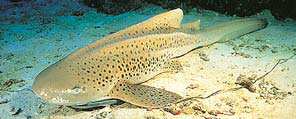STEGOSTOMATIDAE
Zebra Sharks
By Seishi Kimura
 Stegostoma fasciatum |
|
A large shark; maximum size possibly 3.5 m, usually smaller than 2.5 m. Body cylindrical, stout, with prominent ridges on side. Nostrils close to anterior margin of snout, with barbels; nasoral grooves connected with mouth; no circumnarial grooves. Mouth small, located well anterior to eye; teeth small, tricuspid. Eyes without nictitating eyelids. Spiracles large, situated behind eyes. Five small gill slits, the posterior 3 over the pectoral-fin base. Two dorsal fins without spines; first dorsalfin origin well anterior to pelvic-fin origin; second dorsal fin smaller than the first, located just posterior to the first and anterior to anal-fin origin; anal-fin base almost connected with caudal fin, a deep notch between the fins; caudal fin very long, almost a half of total length, with a strong subterminal notch. Vertebrae 207-243. Color: head and body yellow or pale brown with scattered dark or black spots dorsally, whitish ventrally. In juveniles and young, body blackish with yellow vertical bands and spots. Similar families occurring in the area. Stegostomatidae is distinguished from other Indo-Pacific orectolobiform shark families in having a very long caudal fin, almost a half of total length. Hemiscylliidae: origin of second dorsal fin well anterior to origin of anal fin. Ginglymostomatidae: spiracles much smaller than eyes; body without lateral ridge. Remarks. Occurring in tropical and subtropical coastal areas, from South Africa to Japan, Australia, and New Caledonia. Feeds usually on mollusks and small fishes. Oviparous. One species, Stegostoma fasciatum. |

|
|